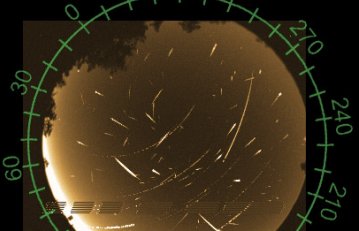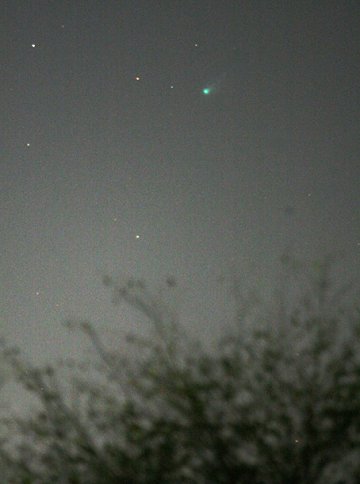 Where's Saturn? Is that a UFO--or the ISS? What's the name of that star? Get the answers from mySKY--a fun new astronomy helper from Meade. Where's Saturn? Is that a UFO--or the ISS? What's the name of that star? Get the answers from mySKY--a fun new astronomy helper from Meade. AURORA WATCH: A solar wind stream is buffeting Earth's magnetosphere and causing mild geomagnetic storms. High latitude sky watchers should be alert for auroras tonight. WEEKEND METEORS: Be alert for meteors, too! Earth is moving through a stream of dust from Halley's Comet, the source of the annual Orionid meteor shower. In Colorado, Chris Peterson has counted 173 meteors shown in this composite image: 
"I recorded these using a video allsky camera from sunset Oct 18 to dawn Oct 20, "explains Peterson. "73 of the meteors are Orionids, with most of the remainder coming from various minor showers: details." The best time to look for Orionids is Sunday morning, Oct. 21st, during the hours before sunrise. If this year's display is like last year's, observers with dark skies will count 20 to 50 meteors per hour: sky map. COMET LONEOS: When the sun goes down tonight, point your camera west just below the bright star Arcturus. Open the shutter for about 30 seconds and--voila!--behold the green blob. It's Comet LONEOS (C/2007 F1). Last night in Turkey, Tunç Tezel tried the procedure and was rewarded as follows: 
Photo details: Canon EOS 5D, 400 mm lens, f/5.6, ISO 3200, 30s.
The bush in the foreground highlights one problem with this pretty green comet: it is very close to the horizon and sets soon after nightfall. This makes the comet a potentially challenging target. A backyard telescope reveals much more than a camera alone. P-M Hedén of Vallentuna, Sweden, took this picture on October 18th using his 3-inch refractor. "This is a very nice comet," he says. "I estimate its magnitude as +6.5." Comet LONEOS will brighten further perhaps to 4th magnitude on Oct 29th when it approaches the sun almost as close as the planet Mercury. Stay tuned for updates. more images: from Peter Heinzen near Raron, Switzerland LONEOS links: sky map, ephemeris, 3D orbit
October 2007 Aurora Gallery
[September Gallery] [Aurora Alerts] | 
